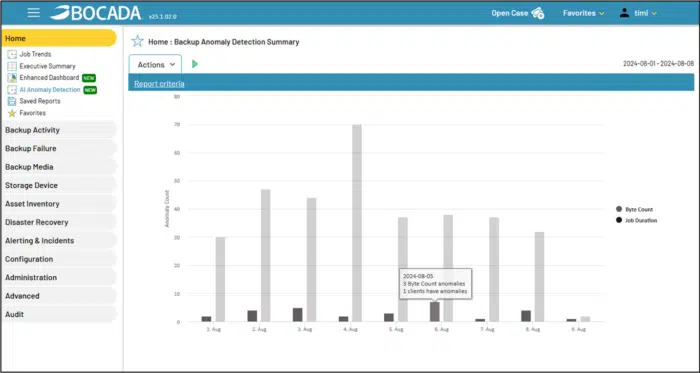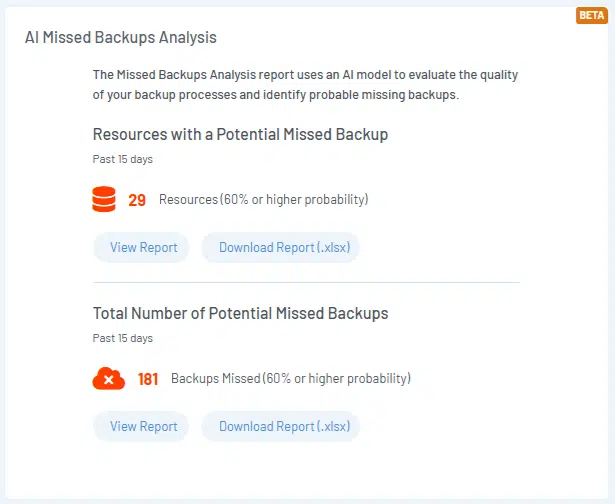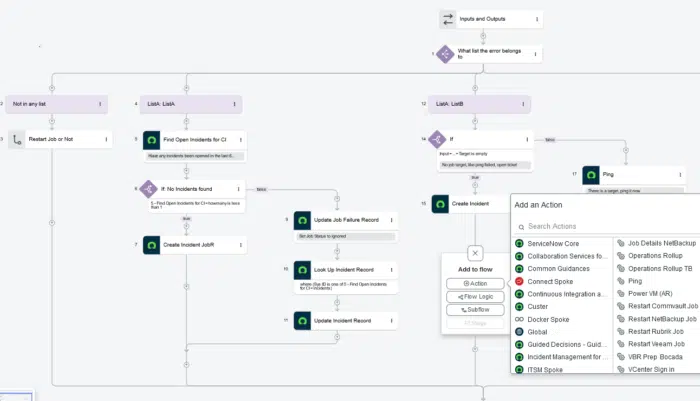IT teams have long relied on a mix of dashboards, reports, and even spreadsheets to track and remediate backup failures. However, as cyber threats grow more sophisticated and data environments expand—spanning on-prem, hybrid cloud, and multi-cloud architectures—traditional approaches to backup monitoring are falling behind.
To future-proof backup monitoring against these IT trends, organizations must move beyond static reporting and embrace the next generation of AI-infused backup monitoring tools. Without these modern tools, IT teams risk missing recovery point objectives (RPOs) and facing catastrophic data loss.
Traditional Backup Monitoring: A Limited View
Many commercial and homegrown backup monitoring solutions focus on the basic reporting features their users think they need:
- Backup success and failure reporting – A pass/fail report that lacks necessary context and supporting details.
- Graphs and tables – Useful for spotting trends but lacking actionable insights (i.e., the “why”) and clear remediation paths.
- Basic alerting – Often lacks IT service desk integration, generating excessive noise without prioritizing critical issues, leading to delayed or ineffective remediation efforts.
While this basic approach may have been sufficient in the past, modern data protection increasingly requires intelligent, proactive monitoring solutions.
The Growing Complexity of Data Protection
The combined rise of cloud computing, ransomware threats, and regulatory demands has made backup oversight more challenging than ever. IT teams now face:
- Expanding data environments – Data is distributed across on-prem servers, private clouds, SaaS applications, and public clouds like AWS and Azure.
- Evolving ransomware threats – Attackers increasingly target backup repositories to prevent recovery, using social engineering and AI-driven phishing attacks to compromise privileged environments.
- Diverse backup configurations – Multiple vendors, solutions, and workloads create fragmented visibility, making it difficult to identify and remediate backup failures.
- Regulatory scrutiny on backups – Due to the growing ransomware threat, compliance frameworks such as NIS2, GDPR, SOC 2, SOX, and HIPAA now emphasize backup security and integrity.
AI-Powered Backup Monitoring
To stay ahead of threats, backup monitoring must evolve beyond basic reporting systems and leverage AI-powered intelligence. Here are three ways Bocada has already infused AI into its backup monitoring platform.
- AI-Powered Backup Anomaly Detection
Backup success does not always equate to backup security. AI-powered anomaly detection helps identify backups that appear successful but exhibit unusual characteristics, such as excessive byte counts or abnormal job durations, which may indicate ransomware encryption.
- Example: A Fortune 500 company using traditional monitoring tools might see normal backup success rates. However, AI-powered backup anomaly detection could flag a backup set whose size has suddenly tripled, signaling potential malicious activity.
Bocada’s AI-powered anomaly detection (announced here) helps IT teams detect, investigate, and mitigate these potential threats before they compromise primary systems.

Bocada Enterprise now offers AI-powered backup anomaly detection. A summary view serves as a launchpad for further investigation into specific anomalies.
- AI-Powered Missed Backup Analysis
Missed backups can occur for various reasons and often go undetected by basic success/failure reports. Many backup monitoring tools fail to recognize when jobs should have run but didn’t, leaving critical data exposed.
Bocada’s AI-driven missed backup report compares recent backup activity against historical patterns to identify missing backups—even when backup policy data is unavailable or difficult to access. This proactive approach works automatically, eliminating the need to tag jobs (e.g., as “daily” or “weekly”), ensuring data protection remains intact.

Bocada Cloud’s Missed Backups Analysis identifies potential missed backups using an AI model that continuously learns from your past backup activity.
- Automated Remediation Based on AI-Determined Root Causes
AI can do more than detect issues—it can automate remediation to minimize manual intervention.
- Bocada Resolve uses AI to determine the root causes of backup failures.
- Based on the identified root causes, IT operations teams can automate remediation workflows to (1), open incident tickets, and (2), resolve common failures automatically, reducing downtime and ensuring compliance with RPOs.

Bocada Resolve empowers IT teams to create automated remediation flows for common backup failures.
Want to enable automated remediation capabilities for your backup operations and IT service desk teams? Request a demo.
Coming Soon: Backup Failure Prediction and Storage Forecasting
Bocada is working on harnessing AI to predict backup failures and provide actionable storage consumption/need forecasts, helping customers prevent gaps in data protection from forming.
Future-Proofing Backup Monitoring with Bocada
In a world where data is more fragmented, vulnerable, and critical than ever, traditional reporting is no longer enough. Organizations need AI-enabled intelligence to stay ahead of threats and ensure business continuity.
Data security is evolving—your backup monitoring should too. Get in touch with Bocada today to explore how AI-infused backup monitoring can help your organization stay ahead of modern risks and compliance requirements.
